The Sphingidae of Alberta
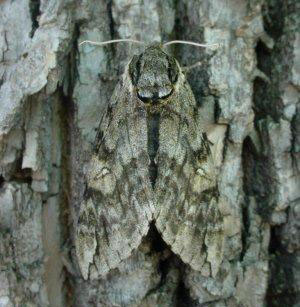

N.B., the files are not linked back to this page.
To return to
this index, simply use your browser back button.
Teacher Kathy Anderson and her class at Woking School in Woking, northern Alberta, report a sighting of Smerinthus cerisyi
May 11, 2006.
To aid with identifications of caterpillars a thumbnail checklist has been added, August 28, 2007. Click on the link: Alberta Sphingidae Larvae.
Sphinginae subfamily
|
Macroglossinae subfamily
Return to Index by NationReturn to Canadian Index Return to Main Sphingidae Index |
I have added Ceratomia amyntor based on larval image sent to me from Drumhellar, courtesy of Burt and Shirley Krull via Sue Brooks.
Felix Sperling writes, "I just found a good example of how our University of Alberta Virtual Museum http://www.entomology.ualberta.ca/ can be useful for doing historical searches.
"A colleague gave me an obituary from the London Times for George Salt, who died in England Feb. 17th, 2003, aged 99. George Salt grew up in Calgary and attended the University of Alberta. After time at Harvard, and much travel and research around the world, he ended up as Reader in Animal Ecology at Cambridge University, doing classic research on insect parasites along the way.
"A search of our Virtual Museum site, using "Salt, George" from the list of collectors in the specimen search function, shows that we have databased about 60 specimens, from 39 species, in the University of Alberta Strickland Museum that were collected by George Salt. Most are lepidoptera, including lots of moths, but also one beetle, and most are from Calgary during 1919 to 1922, when he would have been 15-18 years old.
"Check it out! Notice that if you click on the blue "Collector" above the box in the specimen search that allows you to search for collectors, then you will get an alphabetized list of all collectors.
"Felix Sperling
"ps: If any of you have a website link to the Virtual Museum page, could you please change it to the url above! This new internet address will help us to make the Virtual Museum searchable via Google. However, before the Google Crawler can be enticed into indexing our species pages, we need to have as many links as possible to the site above from other web pages. Thanks!"
I visited the Museum's data base and find it excellent for finding info about species flight times and local distributions.
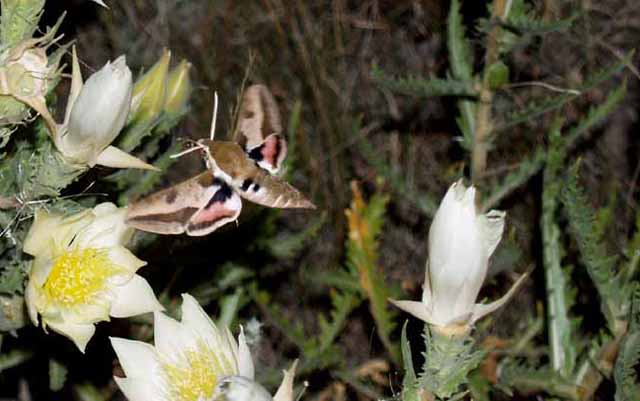
Hyles euphorbiae Lethbridge, Alberta, August 6, 2006,
courtesy of Bruce and Marilyn Bates
"There is another moth much quicker and about half the size. My son and I are trying to get pictures of that one also. I found it interesting that I'd only seen the Eveningstar plant back in the late seventies when my grandparents managed a motel in West Glacier Montana. It was there that I'd seen the Hyles euphorbiae. Shortly after the blossoms opened, the moths would show up. We had no idea what they where and when I ran accross some of the plants here in Lethbridge I told my kids that a moth that flies like a hummingbird would show up. If I get anymore pics I'll forward them to you."
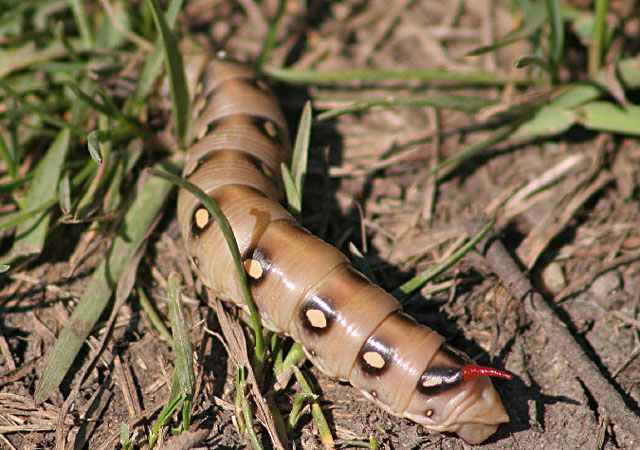
Hyles gallii fifth instar, Edmonton, Alberta, July 2006,
courtesy of Joanne Bovee, via Robert Bercha, id by Bill Oehlke, confirmed by Jim Tuttle.
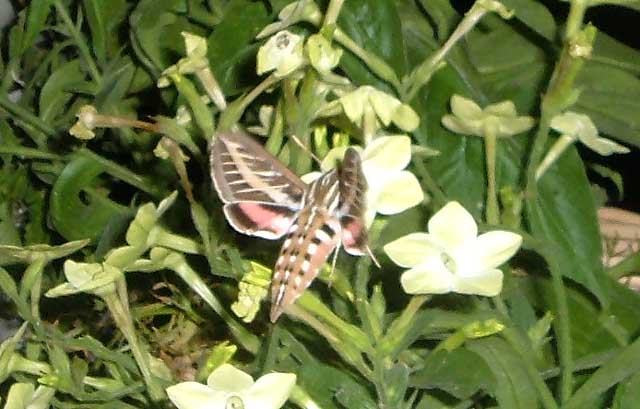
Hyles lineata, Vermilion, Alberta,
August 12, 2007, courtesy of Holly Holmen.
Holly, it is Hyles lineata, a close relative of Hyles euphorbiae. The White-lined Sphinx, probably does not overwinter in your area, but probably migrates, in relatively large numbers from the southwestern states each year and produces one to three broods in your area.
Robert Bercha confirms Hemaris diffinis in Gull Lake area with an image of a prepupal larva. Robert writes, "A friend of mine found this caterpillar on August 14, 2011 near Gull Lake, Alberta. Possibly a sphinx moth caterpillar of some type? Thought you might be interested."
I reply, "You are correct it is a Sphingidae larva, Hemaris diffinis, the Snowberry Clearwing I request permission to post images from links on diffinis file and also on Alberta Sphingidae page.
On August 18 Robert responds, "Thank you for your note back. The caterpillar just pupated today. Iím guessing I need to put it into cold storage for a couple of weeks to get a moth? Any suggestions on the best way to do this?
My thoughts and suggestions: "Because of the date and your location, this pupa may or may not yield a moth this summer. I would not put it into cold storage because the larva may not have developed the enzyme needed to survive a prolonged chill. I suggest you give the pupa about four or five days for the pupal shell to harden and then keep it in an emergence container as described in Care of Found Larvae/Caterpillars: Manduca sexta August 21, 2008, Trina Woodall.
"If it has not eclosed by end of September, then would be the time to put it into cold storage for the winter months. In the spring you could then treat it as per the notes on the same webpage linked above. Cold storage recommendations are also described on the same link. Please let me know what happens for future reference. The moth might eclose in as few as two weeks from pupation date."
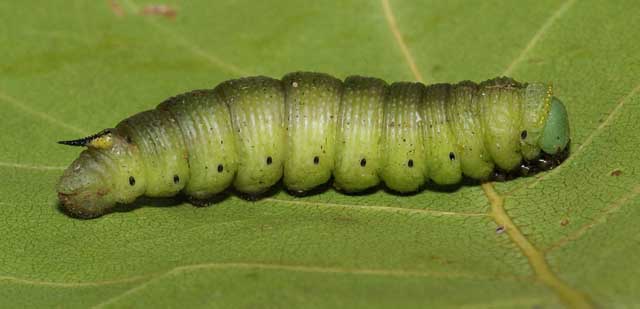
Hemaris diffinis prepupal larva, near Gull Lake, Alberta,
August 14, 2011, photo courtesy of Robert Bercha of larva found by friend.
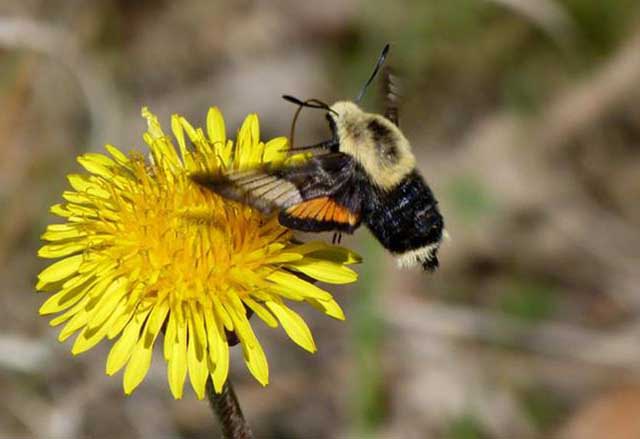
Proserpinus flavofasciata, Fort McMurray, Alberta,
June 1, 2014, courtesy of Jeremy Gatten.
Sphinginae subfamily
Smerinthini Tribe:
Macroglossinae subfamilyDilophonotini Tribe:
See Hemaris comparison to help distinguish the next three species.
Macroglossini Tribe:
|
Use your browser "Back" button to return to the previous page.
This page is brought to you by Bill Oehlke and the WLSS. Pages are on space rented from Bizland. If you would like to become a "Patron of the Sphingidae Site", contact Bill.
Please send sightings/images to Bill. I will do my best to respond to requests for identification help.
This website has been created and is maintained by Bill Oehlke without government or institutional financial assistance. All expenses, ie., text reference support material, webspace rental from Bizland, computer repairs/replacements, backups systems, software for image adjustments (Adobe Photoshop; L-View), ftp software, anti-virus protection, scanner, etc. are my own. The one-time-life-time membership fee that is charged at the time of the registration covers most of those expenses.
I very much appreciate all the many images that have been sent to me, or of which I have been granted permission to copy and post from other websites. All images on this site remain the property of respective photographers.
If you would like to contribute to the maintenace of this website by sending a contribution to
Bill Oehlke
Box 476
155 Peardon Road
Montague, Prince Edward Island, C0A1R0
Canada
your donation would be much appreciated and would be used for
1) paying for webspace rental;
2) paying for computer maintenance and software upgrades;
3) purchases of additional text reference material (journals and books) in an effort to stay current with new species;
4) helping to pay my daughter's tuition (completed spring 2013).
I also hope to expand the North American Catocala site as well as the Sphingidae of the Americas site, to worldwide sites, and that will require additional funds for reference materials, etc. Both of those site are linked from your WLSS homepage.
If you are mailing a check from USA, please use $1.10 postage ($1.15: 2014 rate). Donations can also be made through Paypal via the button below.
Donations are not required to maintain your standing as a WLSS member, nor do they gain you any preferencial treatment with regard to livestock and/or supplies (sleeves), compared to other WLSS members. All WLSS members get first crack at my annual offerings and get an approximate discount of 10% as compared to non-members.
I do usually ask donors if they have any special requests for material on WLSS, and I try to accomodate when appropriate or within my ability to do so.